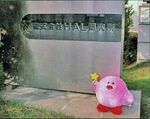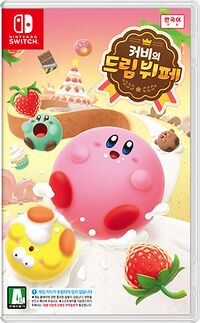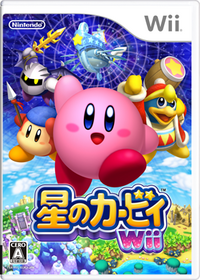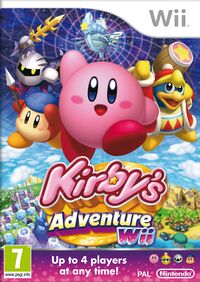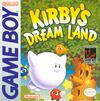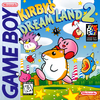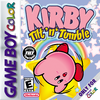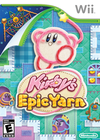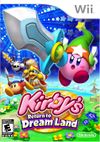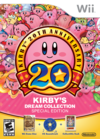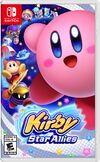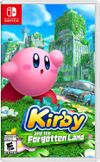User:WillIdleAway/Kirby around the world

| “ | ... some people in the western market said a pink, soft character floating in air would never be accepted. So in the West, they changed Kirby's color on the box from pink to white. Maybe they thought I would not notice. I did! |
” | — Satoru Iwata[1] |
The history of Kirby around the world is one of varying levels of interest and effort in exporting the Kirby franchise and associated properties from HAL Laboratory's home country of Japan to international regions. Certain factors work in favor of worldwide exportation of Kirby, such as the accessible and beginner-friendly gameplay that has been a key part of the series' philosophy since the development of the first game, and the relative lack of dialogue especially from Kirby.[2] Nonetheless, different regions have imported and received different parts of the franchise in their own way.
Kirby in the Asia Pacific region[edit]
Japan[edit]
Kirby enjoys a high level of popularity in HAL Laboratory's home country of Japan, where Nintendo has published every single game in the series except for Kirby's Avalanche (a rebranding of Super Puyo Puyo for Western audiences) and the e-Reader title Kirby Slide. An example of the exceptional popularity of Kirby in Japan can be found in the sales numbers for Kirby Star Allies across fiscal years 2018 and 2019 (April through March of 2017–2018 and 2018–2019). Japan has accounted for just over 20% of worldwide Nintendo Switch hardware sales, with 6.89 million of 32.27 million global sales at the end of 2018[3] (and even at the end of 2022, 27.72 million of 122.55 million[4]). Meanwhile, Japanese sales of Kirby Star Allies accounted for 0.86 million of 2.56 million units sold worldwide, or 34% of worldwide sales. This proportion is high compared to regional sales breakdowns both of Switch hardware and of other games that launched worldwide in FY2018.[5][6] The only comparable game is Splatoon 2, from a franchise that also enjoys exceptional Japanese popularity.[7]
| A comparison of Kirby Star Allies sales against other Nintendo games with a simultaneous FY3/2018 worldwide launch | ||||
|---|---|---|---|---|
| Game | Release date | Fraction of units sold in Japan | ||
| FY3/2018[5] | FY3/2019[6] | April 2017–March 2019 total* | ||
| Mario Kart 8 Deluxe | 2017/04/28 | 1.68M/9.22M (18%) | 0.89M/7.47M (12%) | 2.57M/16.69M (15%) |
| ARMS | 2017/06/16 | 0.47M/1.85M (25%) | n/a** | >0.47M/<2.64M (>18%)** |
| Splatoon 2 | 2017/07/21 | 2.61M/6.02M (43%) | 0.83M/2.69M (31%) | 3.44M/8.70M (40%) |
| Super Mario Odyssey | 2017/10/27 | 1.91M/10.41M (18%) | 0.34M/4.04M (8.4%) | 2.25M/14.44M (16%) |
| Mario Kart 8 Deluxe | 2017/04/28 | 1.68M/9.22M (18%) | 0.89M/7.47M (12%) | 2.57M/16.69M (15%) |
| Xenoblade Chronicles 2 | 2017/12/01 | 0.31M/1.31M (24%) | n/a*** | >0.31M/1.73M (>18%)*** |
| Kirby Star Allies | 2018/03/16 | 0.50M/1.26M (40%) | 0.36M/1.30M (28%) | 0.86M/2.56M (34%) |
| (*Some sums will be approximate at the level of tens of thousands due to rounding errors.)
(**ARMS sold less than one million units during FY3/2019, so a breakdown of Japanese versus overseas sales was not available. Total sales for ARMS numbered 2.10 million up to the end of September 2018, on par with Kirby Star Allies. [40] However, ARMS was no longer a top-selling Switch title at the end of March 2019, when the lowest-selling title listed was Mario Tennis Aces at 2.64 million. [41] This puts an upper bound on worldwide ARMS sales at 2.64 million, and allows us to put a lower bound on the proportion of ARMS sales in Japan at 18%, as either a lower worldwide sales number or more Japanese sales in FY3/2019 would result in the Japanese market accounting for a higher proportion of ARMS sales.) (***Xenoblade Chronicles 2 sold less than one million units during FY3/2019, so a breakdown of Japanese versus overseas sales was not available. As with ARMS we can constrain the fraction indirectly, this time based on a worldwide sales count of 1.73 million given by Monolith Soft's Tetsuya Takahashi in an interview. [42]) | ||||
This proportion can vary significantly from game to game. For Kirby and the Forgotten Land, Japanese sales accounted for 1.62 million of 6.12 million global sales (or 26%) through the end of December 2022. This is still higher than for other games with similarly large sales volumes like Mario Party Superstars (1.67 million of 9.38 million global, or 18%) or Nintendo Switch Sports (1.59 million of 8.61 million global, or 18%), and closer to the Pokémon games between March 2021 and December 2022 (ranging from 25% of the 14.63 million units sold of Pokémon Legends: Arceus to 34% of the 20.61 million units sold of Pokémon Scarlet/Violet).[8] Pokémon in particular enjoys worldwide popularity but is still especially visible in Japan, as evidenced by the 16 Pokémon Center locations across Japan compared to one overseas (in Singapore). The Kirby series finds itself in a similar situation, albeit an order of magnitude smaller.
Kirby: Right Back at Ya! first aired in Japan through TBS Television network affiliates, in particular CBC. Due to its chaotic, parody-heavy nature, Japanese communities have come to refer to it as 和製サウスパーク (wasei sausu paaku, or Japanese South Park).[9] Despite (or perhaps helped by) its occasional darkly satirical bent, the series was well loved at the time of broadcast, with Masahiro Sakurai noting that the series consistently maintained ratings of 5% and above, a very good performance for a show broadcasting at 07:30 in the morning.[10] Almost twenty years after the end of its initial broadcast run, HAL Laboratory would issue a Blu-ray remastered box set with demand so high for it that the first batch of pre-orders sold out within hours, leading the company to ask for patience while they worked to make more orders available.[11]
Merchandising has also been prominent in Japan since the start of the Kirby series, including plush dolls associated with Kirby's Adventure. In the present day, HAL Laboratory's involvement in Kirby merchandising has expanded significantly through involvement in projects like Kirby Café. Anniversary events like the Kirby 25th Anniversary Orchestra Concert and the Kirby 30th Anniversary Music Festival also principally occur in Japan, as do collaborations with brands like Lawson, Zoff, and Suntory.
South Korea[edit]
Korea was under Japanese rule throughout most of the first half of the 20th century, falling under indirect rule in 1905 and being annexed entirely in 1910. The occupation significantly impacted Korean cultural identity, with policies of cultural erasure in place by the late 1930s. Korea regained independence in 1945, and South Korea began normalizing foreign relations with Japan in 1965. However, South Korea remained extremely wary of Japanese cultural influence, and cultural importation from Japan was still strictly forbidden by law through the mid-1990s, when Kirby first appeared in other regions.
Throughout the 1990s, Japanese game imports were indirect, rebadged versions distributed by Korean companies. Hyundai Electronics (defunct 2001, succeeded by a number of companies including SK Hynix) distributed rebadged versions of the NES (as the 현대 컴보이 or Hyundai Comboy)[12], Game Boy (as the 현대 미니컴보이 or Hyundai Mini Comboy)[13], SNES (as the 현대 슈퍼컴보이 or Hyundai Super Comboy), and Nintendo 64 (as the 현대 컴보이64 or Hyundai Comboy 64)[14][15]. Other key Nintendo series like Mario saw imports alongside these consoles, but no record exists of Kirby games being imported. As a result of this, Korean references to Kirby vary greatly in the chosen transliteration, including 커비 (keobi, following the original English name) but also 카비 or 까비 (kabi or kkabi, following the Japanese version of the name).
After Hyundai's exit from the video games business, Daewon CI (대원씨아이) eventually began importing Nintendo consoles and games, and released five Kirby games in Korea under this arrangement: Kirby: Nightmare in Dream Land, Kirby Air Ride, Kirby & The Amazing Mirror, Kirby: Canvas Curse, and Kirby: Squeak Squad. None of these releases involved a translation of the game into Korean. Any translations provided as part of the packaging, instructions, or promotional materials hewed closely to the Japanese version, to the point where transliterations of names of English origin instead resembled their Japanese versions, as with Kirby (카비, kabi) or the Star Rod (스타롯드, suta rosdeu—although the final consonant of 롯 is pronounced more like a "t", rendering it very close to the Japanese スターロッド or sutāroddo). This arrangement of importing untranslated Kirby games continued through the Nintendo DS era, and ended following the establishment of Nintendo of Korea in 2006.
| Kirby games sold in Korea by Daewon CI | ||||
|---|---|---|---|---|
| Game | Korean title | Release date | Notes | References |

|
별의 카비-꿈의 샘 (byeol-ui kabi kkum-ui saem) Kirby of the Stars: The Fountain of Dreams |
2002 | Japanese version with Korean instructions. | [43] |

|
카비 에어라이드 (kabi eeolaideu) Kirby Air Ride |
March 6th, 2004 | US version with Korean box art and instructions. The box art appears to combine the logo used in Western markets with the Japanese artwork of a smiling, unperturbed Kirby. | [44], [45], [46] (Wayback Machine snapshot) |
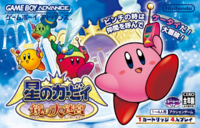
|
별의카비 거울의대미궁 (byeol-uikabi geoul-uidaemigung) Kirby of the Stars: The Great Labyrinth of the Mirror |
May 4th, 2004 | Japanese version with Korean instructions. | [47], [48] |

|
터치! 카비 (teochi! kabi) Touch! Kirby |
April 19th, 2005 | Japanese version with Korean box art and instructions. Included pink stylus. | [49], [50] |
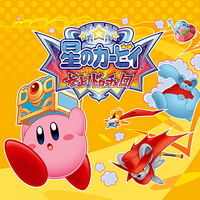
|
별의 카비 드롯체단 등장! (byeol-uikabi deuloschedandeungjang) Kirby of the Stars: The Daroach Gang Appears! |
December 2006 | Japanese version with Korean box art and instructions. Daewon CI never updated their official website to reflect their DS game releases past Kirby: Canvas Curse, but this untranslated import version did exist and was reviewed by a video games magazine. | [51], [52], [53] |
A Korean dub of Kirby: Right Back at Ya! aired on Tooniverse in 2005, airing one episode each weekday afternoon from Monday to Thursday at 16:00, with re-runs airing the same week on Thursday and Friday mornings at 08:00 in hour-long blocks of two episodes. The first episode aired on January 3rd, and the final dubbed episode aired on March 31st.[16][17] The dub is a translation of the US 4Kids dub, and covered the first 53 episodes (in the Japanese broadcast order) except for A Dental Dilemma, for a total of 52 episodes.[18] A summer re-run showed an hour-long block of two episodes every weekday at noon starting on June 17th, changing to a single-episode half-hour block every weekday at 07:00 starting on July 18th until the end of the dubbed run on July 29th.[16][19] A select number of these episodes were also available to view over the Internet on the Junior Naver section of the Naver web portal.[20]
None of these episodes are available today and are considered lost media apart from unofficial audio and video recordings of a limited number of episodes. Despite this, the Kirby: Right Back at Ya! dub is important as it marked the first official transliteration of Kirby as 커비 (keobi), and introduced the earliest examples of Kirby merchandise made for the Korean market in the form of a number of tie-in books and puzzles.[21]
Since Nintendo of Korea's establishment in 2006, the vast majority of Kirby games have received a Korean-language release, starting with the Korean localization of Kirby: Squeak Squad in 2007. The only exceptions have been Kirby's Dream Collection Special Edition (which never received a release outside of Japan and the Americas), Kirby and the Rainbow Curse (for the Wii U, which never released in South Korea), and a number of downloadable 3DS titles (namely 3D Classics: Kirby's Adventure, and Team Kirby Clash Deluxe). Every game is fully translated, although with localization choices ranging from creative (translating Daroach as 도팡 or dopang, a portmanteau of 도둑 or "thief" and Arsène Lupin, the fictional French gentleman thief) to unremarkable (translating 惑星 or wakusei as 혹성 or hokseong, which matches the original kanji one-for-one but is a much less commonly used term for "planet" than 행성 or haengseong) to baffling (transliterating "Waddle Dee", ワドルディ or wadorudi, as 웨이들 디 or weideul di) or even outright wrong (translating だいきんぼしDX or "Big Gold Star" as 커다란 황금 모자 or "Big Golden Hat", due to a misunderstanding of rendaku applying to 星).
Imported Japanese games in South Korea often have changes made to aspects referencing Japanese culture due to South Korea's previous restrictions on Japanese imports. Within the Kirby series, this is most prominently seen with Samurai Kirby in Kirby Super Star Ultra, which received modified sprites to downplay its connection to feudal Japan.
Unusually, Kirby Fighters 2 and Kirby's Dream Buffet received physical boxed releases only in South Korea, although both merely contain a download code in the box rather than an actual game card.
Nintendo of Korea's push for Kirby in Korea has only continued to escalate. The 30th anniversary saw a Kirby pop-up store open in Seoul, operating between July 29th and August 28th of 2022.[22] The store immediately repeatedly reached capacity limits and ran out of stock of various items including Ichiban Kuji prizes.[23] The shop also sold the first Korean-language translations of Kirby novels, namely of Kirby Star Allies: The Great Friend Adventure! and Kirby Star Allies: The Universe is in Trouble?!, weeks in advance of their official publication.[24][25] The pop-up store returned (albeit at a different location) in time for the launch of Kirby's Return to Dream Land Deluxe, between February 17th and March 2nd of 2023.[26]
Other regions[edit]
The Sinosphere saw imports of Kirby games as early as Kirby's Dream Land, fully licensed by Nintendo and with translated manuals and box descriptions.[27] However, after Nintendo's apparent partnership with Chinese companies like Mani and Auldey, mainland China placed severe restrictions on the sale and importing of video game consoles, which persisted through 2015. During this time, Nintendo entered into a joint venture, iQue, to develop Chinese versions of Nintendo consoles to circumvent these restrictions. However, Kirby games were not part of the games lineup for consoles like the iQue Player. Since the removal of these restrictions and Nintendo's partnership with Tencent to sell the Nintendo Switch, Kirby games like Kirby Star Allies have seen Chinese localizations through iQue and Nintendo Hong Kong. Taiwan and Hong Kong were never subject to the same restrictions as mainland China, and games were sold with Japanese region coding through the respective regional Nintendo subsidiaries.
Tie-in properties have also made their way to Chinese-speaking markets, including a Mandarin dub of the anime for the Taiwanese market[28] and a 30th anniversary pop-up store in Hong Kong that operated between February and March of 2023.[29]
In Southeast Asia, while Nintendo continues to extend an official marketing presence[30], no official eShop exists for any country in the region, and physical distribution of games and consoles takes place through a third-party partner, Maxsoft. As a result, interest in Kirby games tends to be low, and other properties like the Kirby anime or novels are not distributed in countries like the Philippines.
Kirby in the Americas[edit]
The United States[edit]
The United States is a key part of Kirby's origin. Following discussions between HAL Laboratory and Nintendo, Nintendo of America provided suggestions for potential names to replace the character's original name of "Popopo" as the Japanese producers wanted a name that would appeal to American children.[31] "Kirby" was chosen from the list due to the humorous contrast between its guttural sound and the character's cutesy appearance, and a significant secondary influence that Shigeru Miyamoto would acknowledge multiple times[31][32] was the role of US attorney John Kirby in defending Nintendo in Universal v. Nintendo, which solidified Nintendo's foothold in America.
Appropriately, the US (along with Canada) was the first market outside of Japan to meet Kirby. 1992's Kirby's Dream Land saw a release there on August 1, a little over four months after the Japanese release. Every Kirby console game has seen a US release since then apart from a couple of Japan-exclusive Super Famicom games (namely the Super Famicom version of Kirby's Star Stacker and the Satellaview-only Kirby's Toy Box mini-games).
One notable aspect of marketing for Kirby games in the United States was the tendency to highlight Kirby's 'rougher and tougher' side to contrast with his normally cute and innocent-looking demeanor. TV commercials for early Kirby games, most particularly those for Kirby's Dream Land, Kirby's Adventure, Kirby's Avalanche, and Kirby's Dream Land 2, were notable in making Kirby look outright intimidating despite his small squishy appearance, with the Kirby's Adventure commercial in particular coining the apt phrase "one tough cream puff". Despite this, however, the box art, instruction booklets, and other direct paraphernalia with the games were generally more in line with the Japanese depiction of Kirby.
With the Kirby anime being created in large part to bolster Kirby's faltering popularity outside of Japan, its 2002 broadcast also coincided with a notable shift in the series' American branding. A new logo design emphasized Kirby's signature inhaling action; Kirby's first dedicated website, kirbykirbykirby.com, was created (largely emphasizing the anime); and, most strikingly, Nintendo of America asked HAL to depict Kirby as tough and determined on the box art and other related game art, with this sometimes being as simple as changing Kirby's face from a carefree smile to a serious dour look (as most aptly illustrated on the box art for Kirby Air Ride). This trend to highlight Kirby's serious side in the U.S. continued with little pause until after Kirby's Return to Dream Land, as from that point on, the box art of subsequent games for both Japan and the U.S. would become largely identical in how it depicted Kirby. When discussing the reasoning for this period of difference in marketing, Kirby series director Shinya Kumazaki had this to say in an interview for GameSpot:
- "For the Japanese versions we are, at [Kirby series developer] HAL, involved in everything throughout development, including the package design. The most powerful image of Kirby is that cute image, we think that's the one that appeals to the widest audience," explained Kumazaki in an interview with GameSpot. This cute Kirby "brings in the most people to play" in his home country of Japan.
- "While it does start cute," Kumazaki continues, "we know there is a serious side to Kirby as well, and throughout the gameplay we see more and more of that, and the games themselves have quite a bit of depth. That being said, we recognise that Kirby's cuteness is his biggest draw in [the Japanese] market."
- Kumazaki asys[sic] Nintendo of America controls the shots in the US, and provides HAL with "feedback and insight" into the market. "What we have heard is that strong, tough Kirby that's really battling hard is a more appealing sign of Kirby, so that's what we feature in the US."[33]
Kirby: Right Back at Ya!, as it was known in North America, was primed to be a significant cornerstone of the Kirby franchise. Kirby: Nightmare in Dream Land, a game created to support the anime's broadcast, featured artwork from the anime in its international marketing, including its box art and television commercials. Localized by 4Kids Entertainment, the goal appeared to be to recreate the earlier smash success of the Pokémon anime, which turned the monster-collecting games into a multimedia empire. Licensing material for Kirby: Right Back at Ya! often emphasized the series' Japanese success and even compared Kirby to comic book superheroes, showing that Kirby had equal or greater recognition. However, as 4Kids was experiencing a downward trend at this point in time, the series gradually lost the company's focus, its broadcast schedule becoming more erratic (though still managing to air all 100 episodes), and the aforementioned kirbykirbykirby.com gradually being rebranded to instead promote the Kirby games.
Though not as widely popular as its home country, American gamers often saw the Kirby series as a "dark horse" among Nintendo franchises in the late '90s and early 2000s. Kirby's early growth in the United States was heavily tied to the growth of the Internet, with early fan sites like The Kool Kirby Spot and Kirby's Rainbow Resort aiming to spread awareness of the series. Fan translations of the Japanese airing of the anime from Operation HNK likewise allowed the series' popularity to flourish among the fledgling online anime community during the mid-2000s.
Throughout the mid-2000s, the series especially grew in popularity thanks to viral videos and memes spread on sites such as YTMND and YouTube, largely pushed forward by the Super Smash Bros. series, which was significantly more popular overseas due to its growing tournament scene — for example, videos remixing the Gourmet Race theme, especially its original Super Smash Bros. version. The English dub of the anime was also famous — or infamous — due to the many creative liberties it took, leading it to become similarly viral; aspects of the series (such as Kirby's "poyo" speech, King Dedede's southern drawl, and Meta Knight's Spanish accent) still remain in the minds of English-speaking Kirby fans to this day.
Super Smash Bros. Brawl gave the Kirby series a wide boost in popularity in the United States thanks to its prominence in the Subspace Emissary story mode, and the addition of Meta Knight and King Dedede as playable fighters, the former of whom is widely considered the most powerful character in the game. Following this, and warm reception to Kirby's Epic Yarn thanks to its unique art style, the series would finally make its mainstream breakthrough in the United States with 2011's Kirby's Return to Dream Land, with subsequent games in the series becoming significantly more successful and leading to widespread awareness among even casual gamers.
Outside of the games and limited home video releases of the anime, merchandise has traditionally been scant, but does exist. Viz Media, a US subsidiary of Shogakukan, publishes a number of Kirby books for the North American market, in particular Kirby Manga Mania and Kirby: Art & Style Collection. Additionally, Nintendo's New York store holds launch events for Kirby games,[34] sells Kirby merchandise,[35] and introduced a set of Kirby statues (originally from the Kirby and the Forgotten Land Universal CityWalk pop-up) to the upper level to commemorate the release of Kirby and the Forgotten Land.[36] Kirby also seems to occasionally make appearances at the store for no particular reason.[37]
HAL Laboratory and Nintendo appear to be making a stronger marketing push for the Kirby series in the United States beginning with the 30th anniversary, with examples of this including a temporary Kirby and the Forgotten Land-themed pop-up attraction at Universal CityWalk in Hollywood,[38] a limited Kirby-themed bubble tea flavor available at Kung Fu Tea (which continued being sold without the Kirby branding when the promotion ended),[39] and more licensed merchandise, including statues from First4Figures[40] and other products for retailers like BoxLunch.[41] As a result, while the series isn't quite at the same level as its native Japan, it is not quite as scarce in the United States as it once was.
Canada[edit]
In general, English-speaking provinces of the country received a lot of the same games and merchandise as the United States did. Initially, video games and their systems sold in French-speaking Québec did not have any mandatory language laws associated with them (meaning game packaging and manuals were most often in English only), but starting in the late 90's (though not actually taking effect until the early 2000's), it became mandatory to provide French-language instruction manuals with the games, even if the games themselves did not have a French translation on them. As a result, most manufacturers started providing bilingual game covers and manuals in English and French, a practice which continues to this day.
Following a deal with the video game industry and the Office québécois de la langue française in 2007,[42] it would eventually become provincial law for all video games sold in retailers across the province to provide bilingual packaging in both languages and a French localization in the game itself if one exists, whether it be the Canadian or European dialect. Needless to say, this change wasn't received positively at first by players who thought this change was unnecessary, had assumed that video games would take longer to come out in North America as a result of how expensive and how long the translation process might take, and would probably import a copy from elsewhere. By the time the change actually took effect on April 1, 2009, besides the occasional scare here-and-there, it didn't really do much harm, probably because the language settings could often be changed, either on a system menu or in the game itself. In regards to the Kirby series, the first game to provide a French-Canadian translation would be Kirby's Epic Yarn, and almost every future game since then (except for Kirby's Dream Collection) would also receive such a translation.
Latin America[edit]
Brazil[edit]
Kirby's history in Brazil is directly tied to Nintendo's: the company has seldom directly distributed its games in the country, instead relying on a third party, or simply not having any official distributor at all, giving fans no choice but having to rely on unofficial importers. Nintendo first officially arrived on Brazil's market in 1993, via Playtronic, which officially released the NES and Game Boy and their games in the country. The series' first game, Kirby's Dream Land, was officially distributed, and Kirby's Adventure even got its own NES bundle in the country.[43][44] Games released in Brazil often mirrored releases in the USA, and most Kirby games released around this period were released in Brazil, including games like Kirby's Dream Land 3. Playtronic was eventually succeeded by Gradiente in 1996, which continued being Nintendo's official distributor until 2003, when it decided to end the partnership, citing the high USD exchange rate, piracy, and other reasons as factors. Brazil would then have no official distributor until 2006, when instead Latamel assumed the role. Once again, releases often mirrored those in the USA; in particular, even Kirby's Dream Collection Special Edition was released in the country. In 2011, Latamel established a local branch called Gaming do Brasil, which then became responsible for distributing Nintendo hardware and software in Brazil. In 2015, Nintendo once again left the country, citing high taxes as the biggest factor.[45] In June 2018, an online Nintendo store with a limited selection of Switch games (one of them being Kirby Star Allies) released without notice,[46] and later on on October 2018, during Brasil Game Show 2018, Nintendo would appear as one of the main sponsors of the convention, where it announced prepaid download cards for a selection of Nintendo Switch titles, which once again included Kirby Star Allies. Nintendo would officially return to Brazil in 2020,[47] focusing more on digital releases than physical games, and this time around without a third party. This meant that physical releases of games were still only possible via unofficial importers. While Nintendo has started selling physical copies in Brazil in 2022 with translated game boxes, the only Kirby game to have an official physical release is Kirby and the Forgotten Land as of August 2023.[48][49][50] Bill Van Zyll, director of Nintendo in Latin America, mentioned that "a couple Kirby games" are coming in physical form to Brazil in an interview on June 2023.[51]
No Kirby game had been official translated to Brazilian Portuguese until Kirby's Dream Buffet in 2022, since, apart from some mobile games, Nintendo games had never been officially translated to Brazilian Portuguese until the release of Mario Party Superstars in 2021, which marked a slow start on games of the company being translated to the main language of Brazil. While various Kirby games were officially released in Brazil before, they were always only available in American English, and any other languages supported in the North American version of said game when applicable. However, game boxes were often translated to Portuguese, but they kept the English terms used in the games to not confuse players.
Videogames only started receiving age ratings in Brazil from 2001 onwards. Before that, ratings were usually assigned informally, based on ESRB ratings of the games, taking inspiration from Brazil's own rating system for other media, and thus, Kirby games released before or in 2001 were rated as following: KA games were rated 6+, and E games were rated L.[52] Ever since the Brazilian advisory rating system started rating videogames, all Kirby games in Brazil received the L rating, with one notable exception: Kirby Star Allies was initially rated L,[53] but the rating was changed to 10 at some point for unknown reasons.[54] Interestingly however, on the official website of Brazil's rating system, Kirby Star Allies is rated L still, but it should be noted that the site does not have a complete list of all media rated, so it's possible that the rating was never updated on the website.
| Kirby games officially sold in Brazil physically | ||||
|---|---|---|---|---|
| Game | Distributor | Notes | References | |
| Playtronic | North American version with the game box in Portuguese. | [54] | ||
| Playtronic | North American version with the game box in Portuguese. | [55] | ||
| Playtronic | North American version with the game box and manual in Portuguese. | [56] | ||
| Playtronic | North American version with the game box in Portuguese. | [57] [58] [59] [60] | ||
| Playtronic | North American version with the game box in Portuguese. | [61] [62] | ||
| Playtronic | North American version with the game box, cartridge and manual in Portuguese. | [63] [64] [65] [66] [67] | ||
| Gradiente | North American version with the game box in Portuguese. | [68] [69] | ||
| Gradiente | North American version with the game box in Portuguese. Released in July 21st, 2000. | [70] [71] [72] [73] [74] | ||
| Gradiente | North American version with the game box in Portuguese. Released in April 30th, 2001. | [75] [76] [77] [78] [79] | ||
| Latamel | [80] | |||
| Gaming do Brasil | North American version with a cardboard cover containing the Brazilian rating in the front, and safety and support information in Portuguese in the back. The description of the game in the back is left in English. | [81] | ||
| Gaming do Brasil | North American version with a cardboard cover containing the Brazilian rating in the front, and safety and support information in Portuguese in the back. | [82] [83] | ||
| Gaming do Brasil | North American version with a small sticker of the Brazilian rating of the game in the front, and another sticker in the back containing safety and support information in Portuguese. The description of the game in the back is left in English. Released on September 2012. | [84] [85] | ||
| Gaming do Brasil | North American version with a cardboard cover containing the Brazilian rating in the front, as well as the description of the game and safety and support information in Portuguese in the back. Released on May 2014. | [86] [87] [88] | ||
| Nintendo / Lojas Americanas | Prepaid download card of the game. Released on October 2018. | [89] [90] [91] | ||
| Nintendo | Game box in Portuguese. Released on August 2023. | [92] [93] | ||
| Kirby games available in Brazil digitally | ||||
|---|---|---|---|---|
| Game | Platform | Release date | Notes | |
| 3DS Virtual Console Nintendo Switch Online |
Unknown February 8, 2023 |
|||
| Nintendo Switch Online | February 13, 2019 | |||
| 3DS Virtual Console | July 12, 2012 | |||
| New 3DS Virtual Console Nintendo Switch Online |
July 27, 2016 September 5, 2019 |
|||
| Nintendo Switch Online | July 21, 2022 | |||
| 3DS Virtual Console | August 1, 2013 | |||
| 3DS Virtual Console | May 17, 2012 | |||
| Nintendo Switch Online | December 12, 2019 | |||
| 3DS Virtual Console | January 17, 2013 | |||
| Nintendo Switch Online | September 5, 2019 | |||
| Nintendo Switch Online | May 20, 2022 | |||
| 3DS Ambassador Program | December 16, 2011 | |||
| Nintendo 3DS | November 17, 2011 | |||
| Nintendo 3DS | May 2, 2014 | |||
| Nintendo 3DS | August 29, 2014 | |||
| Nintendo 3DS | August 29, 2014 | |||
The Kirby anime also released in Brazil with a Brazilian Portuguese dub by Centauro based on the English 4Kids dub, first airing in Fox Kids sometime in 2003,[55] from Monday to Saturday, at 10:30 AM and 10 PM.[56] It would later also air in Jetix, which succeeded and replaced the Fox Kids channel in 2004. The exact period in which the show aired is unclear, but it would air there for a couple more years, until at least 2007.[57] While it's unknown if the whole show was dubbed, as not every episode has been preserved, it's assumed so, due to the sheer variety of episodes preserved, including the last episodes. The Brazilian Portuguese dub of the anime has yet to been rereleased officially after its airing, but during its run two DVDs were released: "Kirby e Seus Poderes" (Kirby and His Powers), which included the first two episodes,[58] and "Kirby e Seus Poderes 2" (Kirby and His Powers 2), which included episodes 3 and 4.[59]
Other kinds of Kirby media, such as merchandise, are not available in Brazil apart from very few imports, most unofficial. For example, Kirby Art & Style Collection is available in Amazon Brazil, but it's simply an import of the English version. The Kirby series does not appear to be widely popular in Brazil; in particular, official marketing of Kirby game has been scarce compared to other Nintendo titles. For example, during Gaming do Brasil's activity, it often held events to celebrate the release of various titles, including third party ones like Lego City Undercover: The Chase Begins,[60] but none were held for any Kirby releases. As another example, after the airing of the Nintendo Direct in February 8th, 2023, the official Twitter account for Nintendo Brasil tweeted about various titles featured in the Direct, but didn't tweet about Kirby's Return to Dream Land Deluxe, despite the Direct revealing a brand new mode for the game, as well as a demo; it is particularly odd when the game features a Brazilian Portuguese translation. On the other hand, Kirby's Dream Buffet's status as the first Kirby game released in Brazilian Portuguese didn't go without notice: the game was notably present in Nintendo's stand in Brasil Game Show in 2022, being playable at the event with its own section which featured a big banner.[61]
Other countries[edit]
Other regions[edit]
Kirby in Europe, the Middle East, and Africa[edit]

Nintendo of Europe have consistently translated material for Kirby games since Kirby's Dream Land, and marketed games from the Kirby series over time. For example, Kirby's Pinball Land featured in one of many Nintendo UK commercials of the time featuring comedian Rik Mayall[62], and the German magazine Club Nintendo even ran a series of comics featuring Kirby as a hardened private investigator.[63] Translation however was not always consistent, leading (for example) to an open letter from the German fan site Kirbytraum about the inconsistency of names that had been used since translated versions of Kirby's Adventure, particularly starting in the 2000s with games like Kirby & the Amazing Mirror.[64]
While the Middle East and Africa tend to be grouped with Europe in dividing up company operations, Nintendo's (and by extension Kirby's) Middle Eastern and African presence is close to nonexistent. However, the anime appears to have been dubbed for a number of Middle Eastern markets, including into Arabic[65], Hebrew[66], and Persian[67].
References
- ↑ GDC 2011 keynote
- ↑ Makiko Ohmoto suggested in particular, in an interview on stage at the Kirby 30th Anniversary Music Festival, that Kirby's lack of intelligible speech might be a factor in Kirby's worldwide popularity. 「逆に、言葉んをしゃべらないから、世界の色んなプレイヤーの方とも繋がれのかな、って最近思います。」 (01:13:22. On the other hand, it may be because [Kirby] doesn't speak in words that [Kirby] connects with all kinds of players around the world. I've thought this as of late.)
- ↑ Nintendo global data, ResetERA summary of Famitsu CY2018 report
- ↑ Nintendo global data, Famitsu CY2022 report
- ↑ 5.0 5.1 [1] (Wayback Machine snapshot
- ↑ 6.0 6.1 [2] (Wayback Machine snapshot)
- ↑ Nintendo Life Feature: Why Is Splatoon So Popular In Japan? (Wayback Machine snapshot
- ↑ [3], [4]
- ↑ See, e.g., articles on the anime from Pixiv, Aniwota Wiki.
- ↑ "アニメ「星のカービィ』制作中のできごと(週刊ファミ通2003年9月12日号、9月19日号揭載)" –桜井政博のゲームについて思うこと Think about the Video Games (エンターブレイン), pg. 66; see also this fan tabulation of average ratings for each episode, which finds an average of 5.23%, matching Sakurai's claim.
- ↑ Twitter link

- ↑ Online encyclopedia entry documenting the Comboy's launch in December 1989
- ↑ Article on the launch of the Super Game Boy as the "Hyundai Super Mini Comboy"
- ↑ Article on the launch of the "Hyundai Comboy 64" (Wayback Machine archive)
- ↑ Pictures of rebadged Nintendo consoles for Korean distribution (Wayback Machine archive)
- ↑ 16.0 16.1 Unofficial compilation of Tooniverse timetables for early 2005 and late 2005
- ↑ Direct Wayback Machine snapshots for confirmation of the original dub run (including its replacement by Panyo Panyo Di Gi Charat in April): [5], [6], [7], [8], [9], [10], [11], [12], [13], [14], [15], [16], [17], [18]
- ↑ A list of episode titles used to be on the Tooniverse website but has been lost; namu.wiki compiles the lost information and notes the omission of A Dental Dilemma in the list of episodes.
- ↑ Direct Wayback Machine snapshots for confirmation of the summer re-run between episodes 3 and "52": [19], [20], [21], [22], [23], [24], [25]
- ↑ Wayback Machine snapshot of the Junior Naver portal, with a prominent advertisement for the fourth episode; character bios from a later version of the portal; episode titles and timings for the first eight episodes
- ↑ Kyelim Books search results for Kirby, featuring a comic adaptation using stills from five of the episodes, an illustrated book featuring a jigsaw puzzle, an activity book, and a 65-piece puzzle; Korean blog reviewing the comic adaptation
- ↑ https://www.nintendo.co.kr/news/view.php?no=YUNMT0o0bTFBaitGUGdOamZaVFREUT09 Nintendo of Korea's announcement news post] (Wayback Machine snapshot)
- ↑ Twitter account of the Kirby pop-up shop (Wayback Machine snapshots during the first iteration and after announcement of the second iteration)
- ↑ Photos from the pop-up shop one day before its opening
- ↑ Product information for the first and second novels clearly show an official street date of August 10th.
- ↑ Nintendo of Korea's announcement of the pop-up store's second iteration (Wayback Machine snapshot)
- ↑ [26][27]
- ↑ Internet Archive repository for the Taiwanese dub
- ↑ Nintendo HK pop-up store website (Wayback Machine snapshot)
- ↑ [28]
- ↑ 31.0 31.1 shmuplations.com translation of a 1993 interview with Kirby's Adventure staff
- ↑ Miyamoto Talks Wii, Zelda And Nintendo's Past - Game Informer
- ↑ GameSpot article: "Why is Kirby always angry in the US? Nintendo explains", published on April 28, 2014
- ↑ Nintendo NY tweets about launch events for Kirby: Triple Deluxe, Kirby and the Rainbow Curse, Kirby: Planet Robobot, Kirby Star Allies, and Kirby and the Forgotten Land
- ↑ Example tweets from Nintendo NY: [29] [30]
- ↑ Nintendo NY tweets about the statues: [31] [32] [33]
- ↑ Kirby sightings reported at/by Nintendo NY: [34] [35]
- ↑ Overview of the Kirby and the Forgotten Land CityWalk pop-up
- ↑ Announcement of the Kirby Kung Fu Tea collaboration
- ↑ The "We Love Kirby" statue from First4Figures
- ↑ Licensed Kirby merchandise at BoxLunch
- ↑ OQLF press release on the deal
- ↑ Video showcasing the Brazilian NES bundle with Kirby's Adventure (Portuguese)
- ↑ Another video showcasing the Brazilian NES bundle with Kirby's Adventure (Portuguese)
- ↑ Nintendo Blast article announcing the end of Nintendo's distribution in Brazil by Gaming do Brasil (Portuguese)
- ↑ [36]
- ↑ [37]
- ↑ Adrenaline article announcing the physical copies (Portuguese)
- ↑ Tweet from Brazilian Youtuber Coelho no Japão showcasing the boxes
- ↑ Nintendo Blast article announcing more physical copies, including Kirby and the Forgotten Land (Portuguese)
- ↑ Interview with Bill Van Zyll
- ↑ Nintendo World, edition 28
- ↑ [38]
- ↑ [39]
- ↑ TV programming in Brazil from July 7th, 2003
- ↑ Nintendo World magazine, edition number 65
- ↑ Recording of Jetix in Brazil from 2007, which shows the anime airing there
- ↑ "Kirby e Seus Poderes" in Imagem Filmes' site
- ↑ "Kirby e Seus Poderes 2" in Imagem Filmes' site
- ↑ Nintendo Blast article about a meetup event for Lego City Undercover: The Chase Begins (Portuguese)
- ↑ Video showcasing Nintendo's stand in Brasil Game Show in 2022 (the Kirby's Dream Buffet section is shown at 3:50)
- ↑ YouTube copy of the ad
- ↑ Kirby's Rainbow Resort section on the Club Nintendo comics
- ↑ Kirbytraum open letter (Wayback Machine snapshot)
- ↑ Clip of the Arabic dub on YouTube
- ↑ Internet Archive copy of the Hebrew intro
- ↑ Internet Archive collection of the Persian dub
